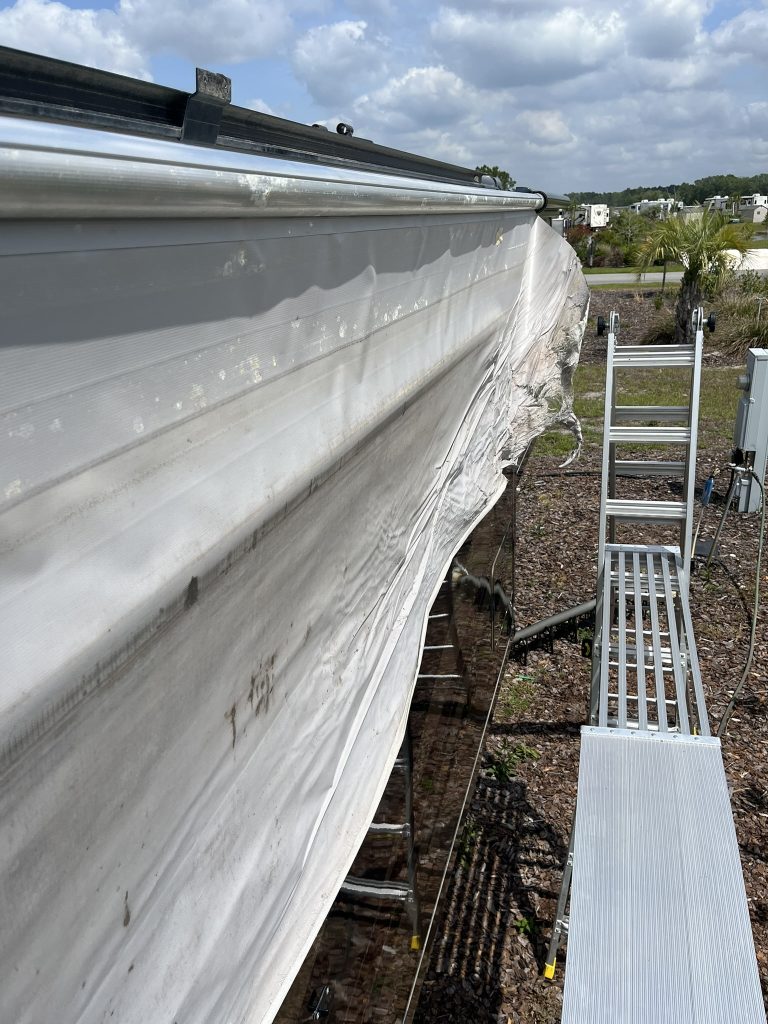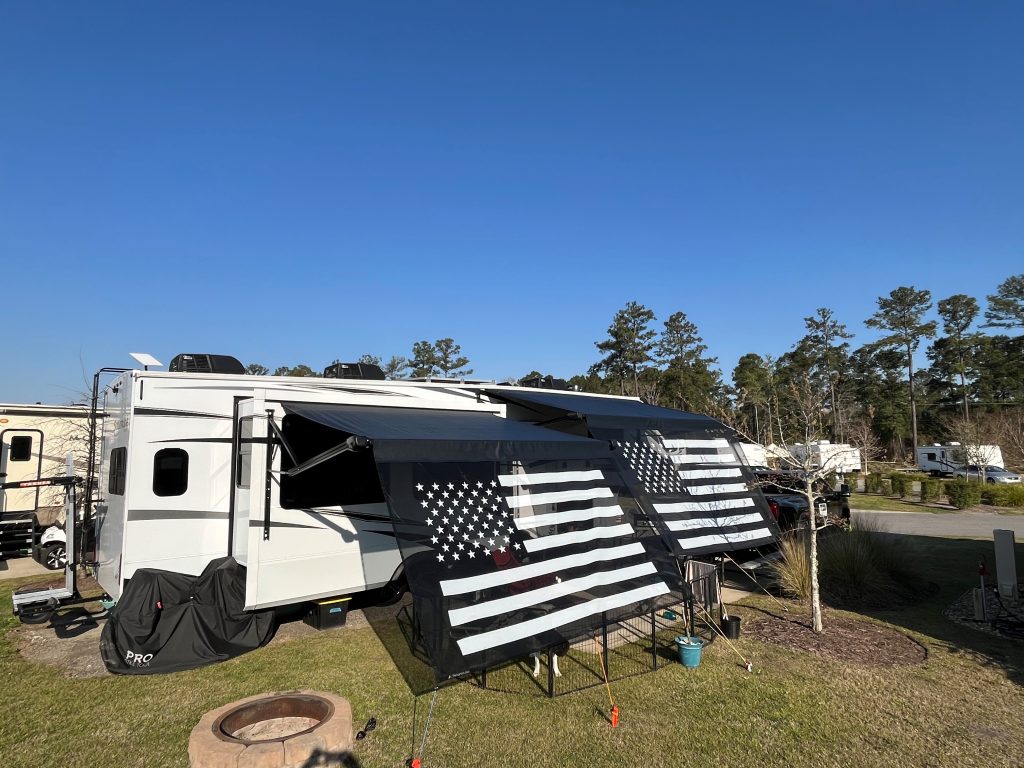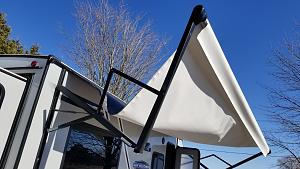
Picture this: You’re on the open road, living your best RV life, when suddenly you notice a tear in your awning or a sagging slide topper. 😱 These essential components of your mobile home not only provide shade and protection but also contribute significantly to your comfort on the road. Yet, they’re often overlooked until a problem arises.
Did you know that proper maintenance can extend the life of your RV awning and slide toppers by up to 5 years? 🤔 That’s right! Regular inspection and care not only save you money in the long run but also ensure your RV adventures aren’t cut short by unexpected issues. But here’s the catch – many RV owners aren’t sure how to properly maintain these crucial elements.
In this guide, we’ll walk you through the ins and outs of inspecting and maintaining your RV awning and slide toppers. From understanding their structure to addressing common issues, we’ve got you covered. So, buckle up and get ready to become a pro at keeping your RV’s exterior in top-notch condition! 🚐✨

Understanding RV Awnings and Slide Toppers
Types of RV awnings
RV awnings come in various types, each designed to serve specific purposes and suit different RV styles. Here’s a breakdown of the most common types:
- Manual Awnings: Operated by hand, requiring physical effort to extend and retract
- Electric Awnings: Powered by a motor, allowing for easy operation with the push of a button
- Slide-Out Awnings: Specifically designed to cover slide-out sections of the RV
- Window Awnings: Smaller awnings that provide shade and protection for individual windows
- Patio Awnings: Large awnings that create an outdoor living space next to the RV
| Awning Type | Pros | Cons |
| Manual | Cost-effective, simple mechanism | Requires physical effort |
| Electric | Easy to operate, convenient | More expensive, potential motor issues |
| Slide-Out | Protects slide-out mechanism | Limited coverage area |
| Window | Targeted shade, improved privacy | Smaller size, less versatile |
| Patio | Creates large outdoor living space | May be too large for some campsites |
Purpose and benefits of slide toppers
Slide toppers serve as protective covers for the top of RV slide-outs. Their primary purposes include:
- Preventing debris accumulation on slide-out roofs
- Protecting slide-out seals from UV damage
- Reducing water intrusion around slide-out edges
Benefits of using slide toppers:
- Extended lifespan of slide-out mechanisms
- Improved energy efficiency by reducing heat transfer
- Decreased maintenance requirements for slide-out areas
- Enhanced overall RV appearance
Common materials used
RV awnings and slide toppers are typically made from durable materials designed to withstand outdoor conditions. The most common materials include:
- Vinyl: Waterproof, easy to clean, and resistant to mildew
- Acrylic: Breathable, fade-resistant, and quick-drying
- Polyester: Lightweight, durable, and resistant to stretching
- Canvas: Traditional material, breathable but requires more maintenance
Each material has its own set of advantages and considerations. For example, vinyl is excellent for water resistance but may not breathe as well as acrylic. Understanding these materials helps RV owners make informed decisions about maintenance and replacement.
Regular Inspection Routine
A. Frequency of inspections
Regular inspections are crucial for maintaining your RV awning and slide toppers. Aim to inspect these components:
- Before and after each trip
- Monthly during the camping season
- At least once during off-season storage
| Inspection Type | Frequency |
| Quick visual check | Before/after each trip |
| Thorough inspection | Monthly |
| Off-season check | Once during storage |
B. Visual checks for damage
When performing visual checks, look for:
- Tears, holes, or fraying in the fabric
- Rust or corrosion on metal parts
- Loose or missing screws
- Signs of mold or mildew
- Debris accumulation in tracks or rollers
C. Testing mechanical components
To ensure proper functioning:
- Extend and retract the awning fully
- Listen for unusual noises
- Check for smooth operation
- Inspect arms and support brackets
- Test locking mechanisms
D. Assessing fabric condition
Evaluate the fabric’s condition by:
- Checking for fading or discoloration
- Testing water repellency
- Examining seams for separation
- Feeling for brittleness or stiffness
Now that you understand the importance of regular inspections, let’s move on to the proper cleaning techniques for your RV awning.
Cleaning Your RV Awning
Recommended cleaning products
When it comes to cleaning your RV awning, using the right products is crucial. Here’s a list of recommended cleaning solutions:
- Mild soap or dish detergent
- Specialized RV awning cleaner
- White vinegar (for mold and mildew)
- Bleach solution (for tough stains)
- Microfiber cloths or soft-bristled brushes
| Product Type | Pros | Cons |
| Mild soap | Gentle, readily available | May not remove tough stains |
| RV awning cleaner | Specifically formulated, effective | More expensive |
| White vinegar | Natural, eco-friendly | Strong odor |
| Bleach solution | Powerful stain remover | Can damage fabric if overused |
Step-by-step cleaning process
- Extend the awning fully
- Rinse with water to remove loose debris
- Apply cleaning solution with a soft brush
- Gently scrub the entire surface
- Rinse thoroughly with clean water
- Repeat if necessary for stubborn stains
Addressing mold and mildew
Mold and mildew can be persistent problems for RV awnings. To tackle these issues:
- Mix equal parts white vinegar and water
- Spray the solution on affected areas
- Let it sit for 15-20 minutes
- Scrub gently with a soft brush
- Rinse thoroughly and allow to dry completely
Drying and storage tips
Proper drying and storage are crucial for maintaining your RV awning:
- Extend the awning fully after cleaning
- Allow it to air dry completely
- Avoid rolling up a damp awning
- Store in a cool, dry place when not in use
- Consider using a protective cover during extended storage
Now that your RV awning is clean and properly cared for, let’s move on to maintaining your slide toppers, which are equally important for your RV’s overall condition and functionality.
Maintaining Slide Toppers
Debris removal techniques
Keeping your RV slide toppers free from debris is crucial for their longevity and functionality. Here are some effective techniques:
- Gentle brushing: Use a soft-bristled brush to sweep away loose debris
- Leaf blower: For stubborn debris, a leaf blower can be highly effective
- Microfiber cloth: Wipe down the surface to remove fine particles
- Water rinse: Use a low-pressure hose to wash away remaining debris
| Method | Best for | Frequency |
| Brushing | Light debris | Weekly |
| Leaf blower | Heavy debris | Monthly |
| Microfiber cloth | Fine particles | After each trip |
| Water rinse | Final cleaning | Monthly |
Lubricating moving parts
Proper lubrication ensures smooth operation of your slide toppers. Focus on:
- Roller tubes
- Spring assemblies
- Mounting brackets
Use a silicone-based lubricant spray for best results. Apply sparingly to avoid attracting dust.
Checking for proper tension
Correct tension is vital for slide topper performance. To check:
- Extend the slide-out fully
- Observe the topper fabric
- Look for a slight downward bow (about 1-2 inches)
- Adjust tension if necessary using the roller tube mechanism
Remember, over-tightening can cause premature wear, while loose toppers may flap in the wind. Now that we’ve covered slide topper maintenance, let’s move on to addressing common issues that may arise with your RV awnings and toppers.
Addressing Common Issues
Repairing small tears and holes
Small tears and holes in your RV awning or slide topper can quickly escalate into larger problems if left unattended. Here’s how to address these issues:
- Clean the damaged area thoroughly
- Apply a patch or sealant designed for RV awnings
- Allow proper drying time before retracting the awning
| Repair Method | Pros | Cons |
| Patch Kit | Easy to apply, durable | May be visible |
| Liquid Sealant | Blends well, flexible | Requires precise application |
| Tape | Quick fix, waterproof | Temporary solution |
Fixing alignment problems
Misaligned awnings can cause uneven tension and premature wear. To fix:
- Extend the awning fully
- Check for even deployment on both sides
- Adjust the fabric, roller tube or arms as needed
- Lubricate moving parts to ensure smooth operation
Replacing worn-out parts
Over time, certain components may need replacement:
- Springs
- Fabric
- Arms or brackets
- Roller mechanism
Always use manufacturer-recommended parts for optimal performance and longevity.
When to seek professional help
While many issues can be DIY-fixed, some situations warrant professional assistance:
- Complex mechanical failures
- Large tears or extensive fabric damage
- Electrical problems with motorized awnings
- When you’re unsure about the repair process
Now that we’ve covered common issues and their solutions, let’s explore how to protect your investment and extend the lifespan of your RV awning and slide toppers.
Protecting Your Investment
Proper storage during off-season
When your RV is not in use, proper storage of awnings and slide toppers is essential:
- Clean thoroughly before storage
- Ensure they are completely dry
- Retract fully and secure tightly
Weather considerations
Be mindful of weather conditions to protect your RV awning and slide toppers:
- Retract during high winds or storms
- Avoid extended exposure to harsh sunlight
- Never leave your awnings out unattended

By implementing these protective measures, you can significantly extend the life of your RV awning and slide toppers, ensuring they remain functional and attractive for years to come. Next, we’ll recap the key points discussed throughout this guide to help you maintain your RV’s exterior features effectively.
Regular inspection and maintenance of your RV awning and slide toppers are crucial for extending their lifespan and ensuring they function properly during your travels. By implementing a routine that includes cleaning, addressing common issues, and taking preventive measures, you can protect these valuable components of your RV from wear and tear.
Remember, a well-maintained awning and slide toppers not only enhance your camping experience but also contribute to the overall value of your RV. Take the time to care for these essential features, and they’ll continue to provide shade, protection, and comfort for many adventures to come. Happy camping and safe travels!
Lasting Memories Mobile RV Services is at Keystone Heights RV Resort in Florida. We will be servicing Keystone Heights, Bradford & Clay County Florida and the surrounding areas. Schedule your tank cleaning, repair and maintenance appointment now.
